Unexpected diversity of waterbirds in swamps and marshes of Guatemala
We went to Monterrico in January to find and photograph white pelicans to see if the male pelicans had the crest on their beaks of mating season. Totally unexpected, we found hundreds and hundreds of white pelicans in V-shaped groups feeding together en masse. Just as they (like ducks, geese and some other birds) fly in V-shaped formation, on the water they were partially sometimes in V-formation (but with both sides parallel to each other in order to assist each other in finding-and-feeding).
Not one single pelican near the Pacific Coastal swamps and marshes had a raised crest, so clearly for these migratory birds, January 2021 was not even the beginning of breeding system. Curiously, the day before, January 15, 2021, about 60 km to the northeast, every male white pelican had the expected temporary raised crest (in the lagoon of Auto Safari Chapin). But these pelicans live there all year; they are not in cages; their wings are not clipped, but they are so content with their lagoon and the food they get that they stay here all year. I estimate that the difference between these resident white pelicans and migratory white pelicans has not previously been studied by ornithologists. So I hope our photographic documentation helps. We will be publishing all these photographs in coming weeks. The present page is to mention finding seven species of waterbirds that had gathered together in an inlet at the edge of a lagoon near Monterrico.
On Jan 16th we went to explore the mangrove swamps and tule reed marshes northwest of Monterrico. Once we entered the Laguna Puente Grande we saw, almost a kilometer away, “many hundreds” of white pelicans in a row. There were so many together that they formed a white band on the horizon of the far end of the lagoon.
Because this lagoon has water less than 2 feet deep, the blades of the motor boat kept hitting the mud, so we could not move very fast. We noticed that the birds were in constant movement (they were easily over half a kilometer away, so they could not hear or see us; they were moving because this is how they fish). We estimate they are after crabs perhaps at this time of year. Clearly the pelicans have evolved a way to hunt together to capture more of whatever it is on the bottom of the shallow lagoon that they love to gobble down. We have over 200 photographs of the several groups of these pelicans. I have never seen anything like this in Guatemala before, but these birds surely do this every year here. The brown pelicans, Pelecanus occidentalis, of Rio Dulce and Amatique Bay are diving birds; diving into deep water. The white pelicans of Monterrico float on the surface and stick their long beaks down underwater. They do not (normally) dive underwater; they don’t need to because the surface of the bottom is within the reach of their beak (which is at the end of their long neck).
We took so many photos the first day we decided to return the next day (Sunday, Jan. 17, 2021). But on this additional day everything was different. When we got to the lagoon, not a single pelican. So we went back to the Canal de Chiquimulilla and went to another lagoon. Zilch here (though we did find and photograph lots of herons and other wading birds while going back and forth between the lagoons).
So I decided to return back to Laguna Puente Grande and noticed pelicans flying in, group after group flying in. Whether they were flying in from where they spent the night, or flying from another lagoon, we don’t know. Was 7-ish in the morning.
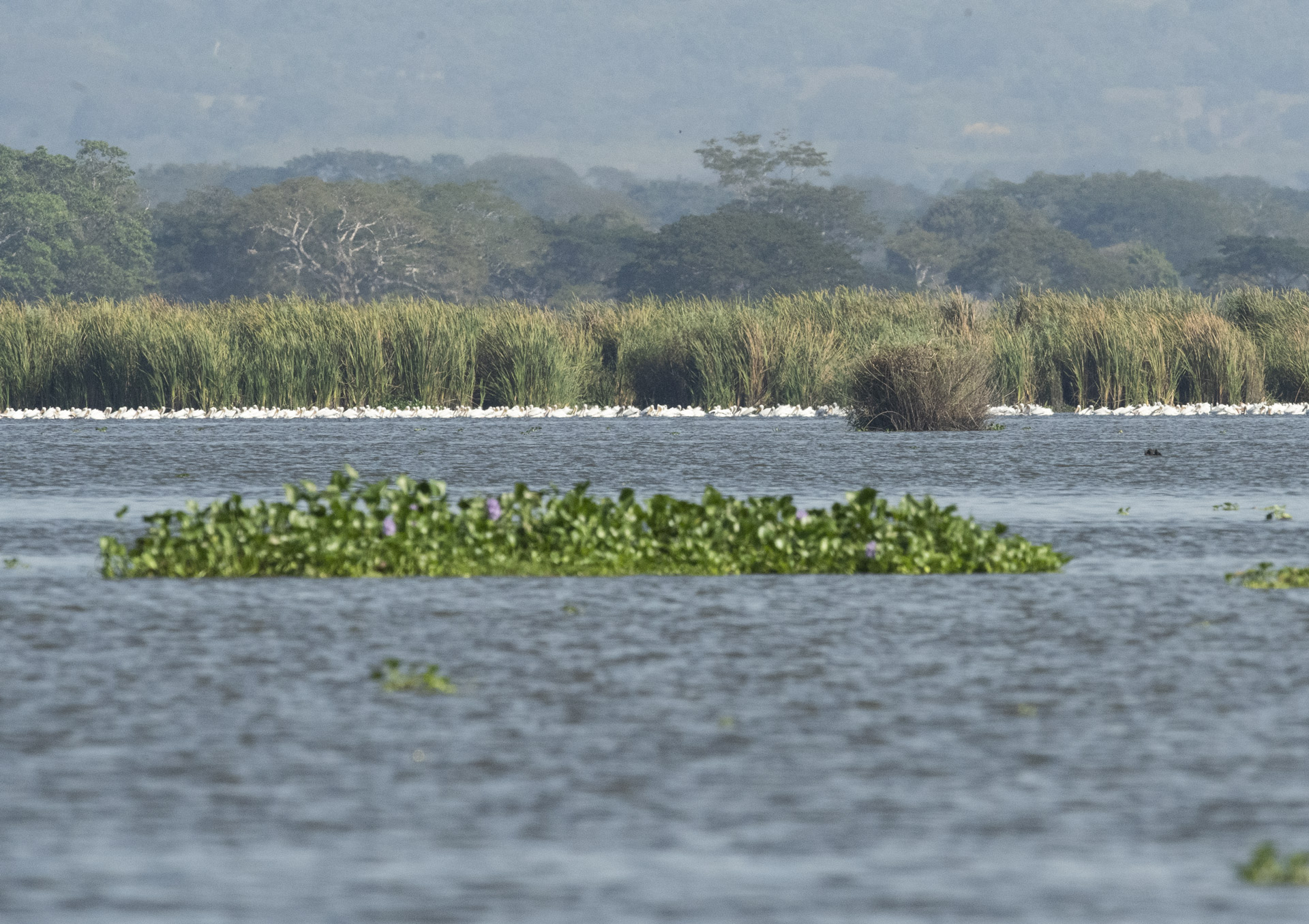
This is the first photograph, after we saw the “white line” earlier. Now we have approached within several football fields distance so with 800mm prime lens we can notice that the white line is several parallel lines of white pelicans.

Now we realize this white mass is solid white pelicans. Laguna Puente Grande, Monterrico area.
Photograph by Nicholas Hellmuth with Nikon D5 camera, 800mm prime Nikkor lens, January 16, 2021.
The day before we had spotted the pelicans because they form long lines (I estimate 40 to 60 or even 70 meters long). When you look at the horizon (the far far far end of the lagoon) you see a white line; you are so far away you can’t see anything but a white line. But yesterday I learned this is a long row of multiple parallel lines of white pelicans; each line shoulder-to-shoulder. So they form a total white area; a white band that you can see from over a kilometer away.
These bands move fast, so by the time our boat could get through the low water (and high mud floor) all the lines had gone away. But there were widely spaced lines of pelicans flying parallel to the edge of the lake. And there was still one short (20 meter wide) white line area at the far far end of the lagoon. So I decided to photograph these pelicans first, and then turn left and find the rapidly swimming gigantic total length of the larger pelican lines.
But once we were several hundred meters away, looking through my 800mm prime Nikkor lens on Nikon D5 camera, I was able to notice that the white mass was not pelicans, it was a mass of great white herons (Ardea alba¬, also known as great white egrets).

Once we got “closer” (several football fields distance) I began to take photographs with the Nikon 800mm prime telephoto lens.
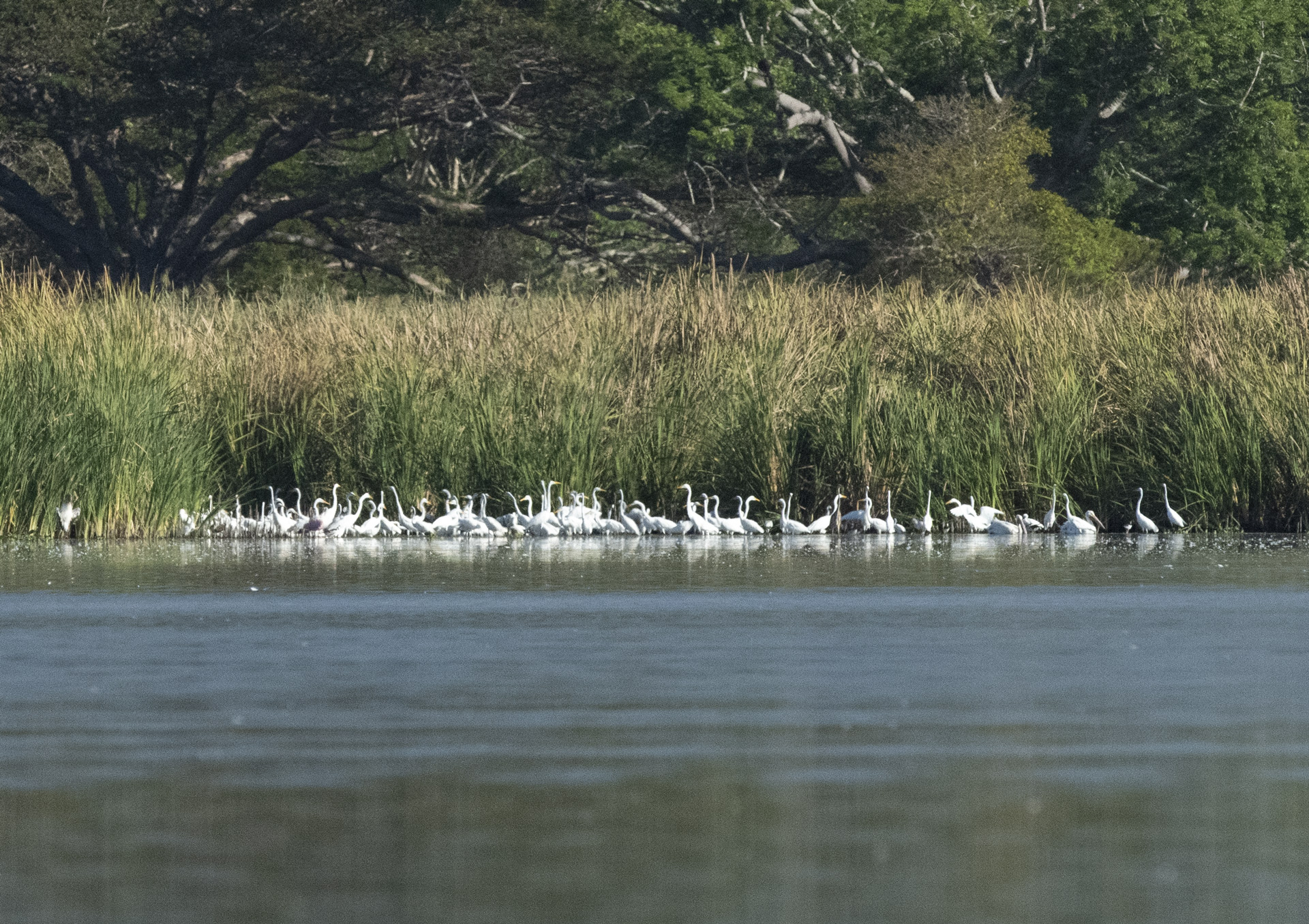
Now I realized this was not a mass of white pelicans, it was an unexpected mass of great white egrets.
Photograph by Nicholas Hellmuth with Nikon D5 camera, 800mm prime Nikkor lens, January 16, 2021.
The great white heron is the most common bird of most of the Neotropical wetlands of Guatemala. We see them everywhere; but rarely more than a few in the same area. Today we saw dozens (potentially up to a hundred) crammed shoulder to shoulder in a tiny inlet, perhaps 20 meters wide by perhaps 5 meters deep. I estimate they were in this area because it was rich with crabs or baby frogs or fish or something. I do not believe they spent the night standing in the water.
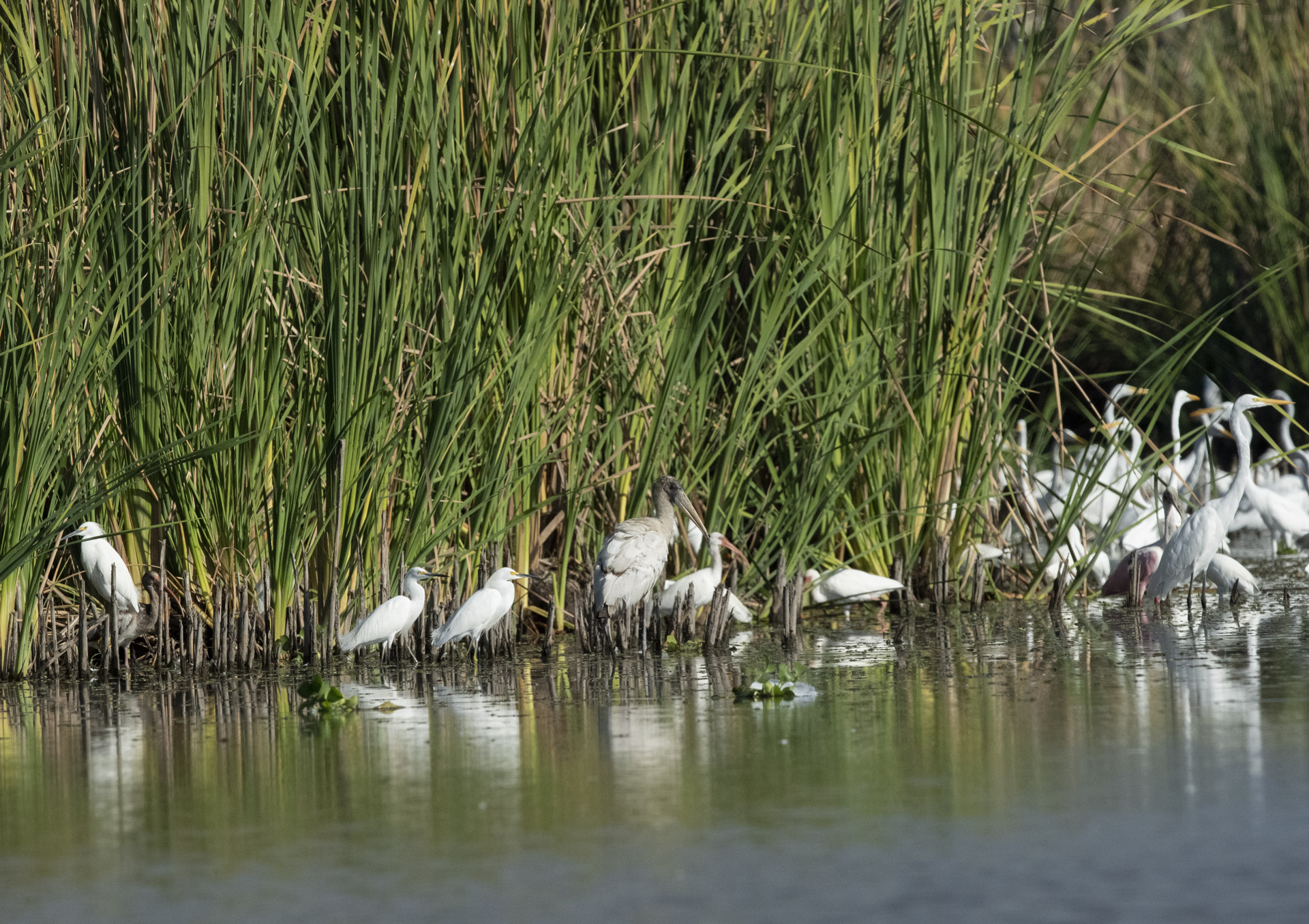
At the left are mostly Ardea alba, Garza blanca, Great white heron, Great white egret.
At the right are two white egrets but with black beak: Egretta thula, Garceta nívea, Snowy egret.
Tall bird with grey head is a solitary Cigueña, Wood Stork, Mycteria americana.
Photograph by Nicholas Hellmuth with Nikon D5 camera, 800mm prime Nikkor lens, January 16, 2021.
As I got within a hundred meters I noticed there was a single solitary wood stork at the left, Mycteria americana, Cigueña. I then noticed there were one or two darker herons Ardea herodias, Garza gris, Great blue heron. I then noticed several white egrets but with black beaks, Egretta thula, Garceta nívea, Snowy egret (the mass of Ardea alba birds had yellow beaks). Then I saw a flash of pink, which I estimated was probably a roseate spoonbill, Platalea ajaja, Espátula Rosada. And when I enlarged the photos in Adobe Photoshop I noticed other species of wading birds including Himantopus mexicanum, Candelero, Black-necked. And when Victor Mendoza examined my raw files (.NEF format from Nikon raw) he found a white ibis that I had not noticed (since they are identical white to the larger Ardea alba, and also have orange beaks; but Victor noticed that the beaks of some of the “white herons” were curved and he correctly recognized that these were not Ardea alba.
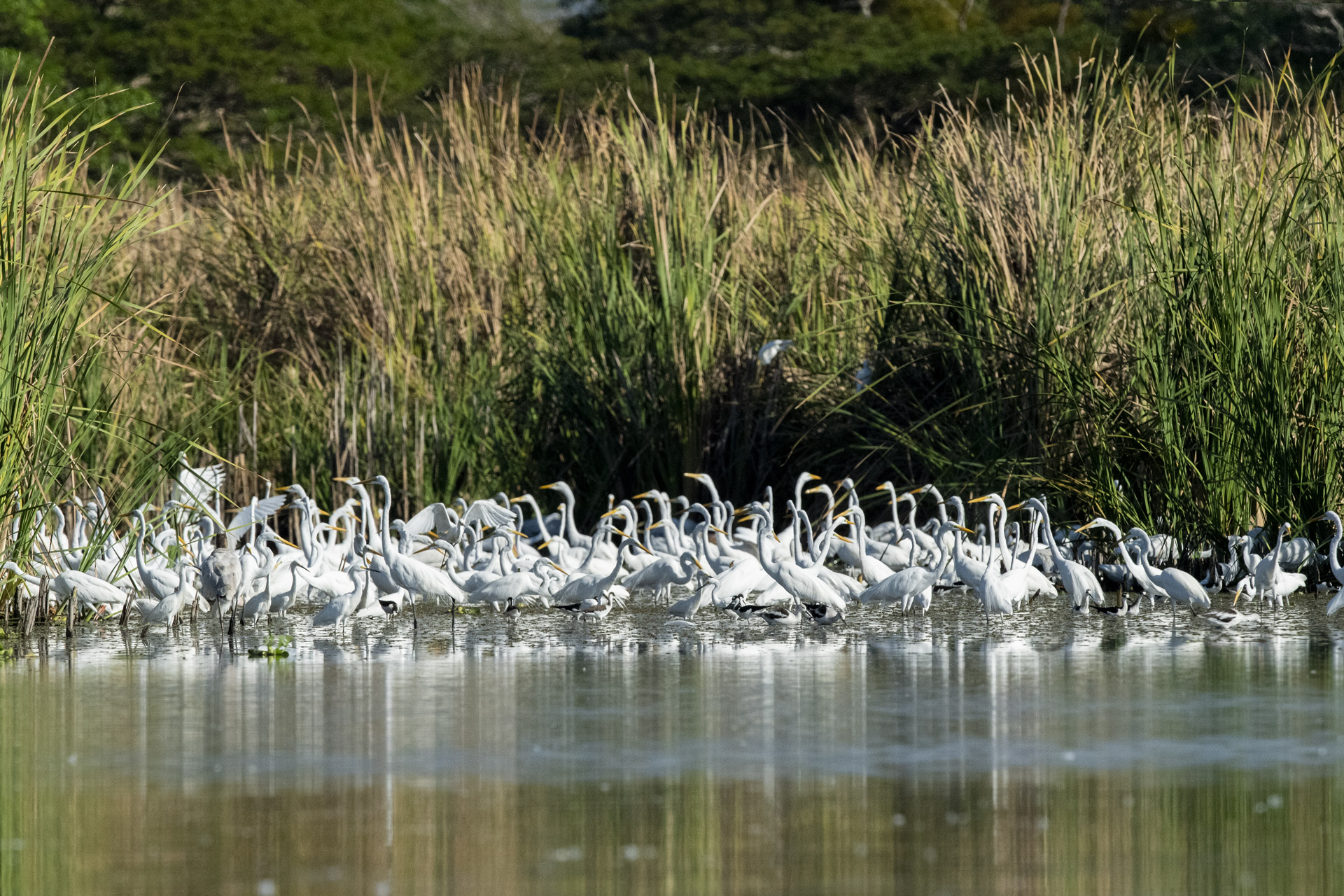
Several small wading birds, Himantopus mexicanum, Candelero, Black-necked stilt, are in front, at the right.
Photograph by Nicholas Hellmuth with Nikon D5 camera, 800mm prime Nikkor lens, January 16, 2021.

Solitary Mycteria americana, wood stork, at left of the mass of Ardea alba, great white herons, inlet at far end of Laguna Puente Grande, Monterrico. In the other photo the wood stork is facing inwards so you can barely notice its hind end.
Photograph by Nicholas Hellmuth with Nikon D5 camera, 800mm prime Nikkor lens, January 16, 2021.
So between the two of us we now have a list of eight birds that had gathered together all crammed into a single tiny area.
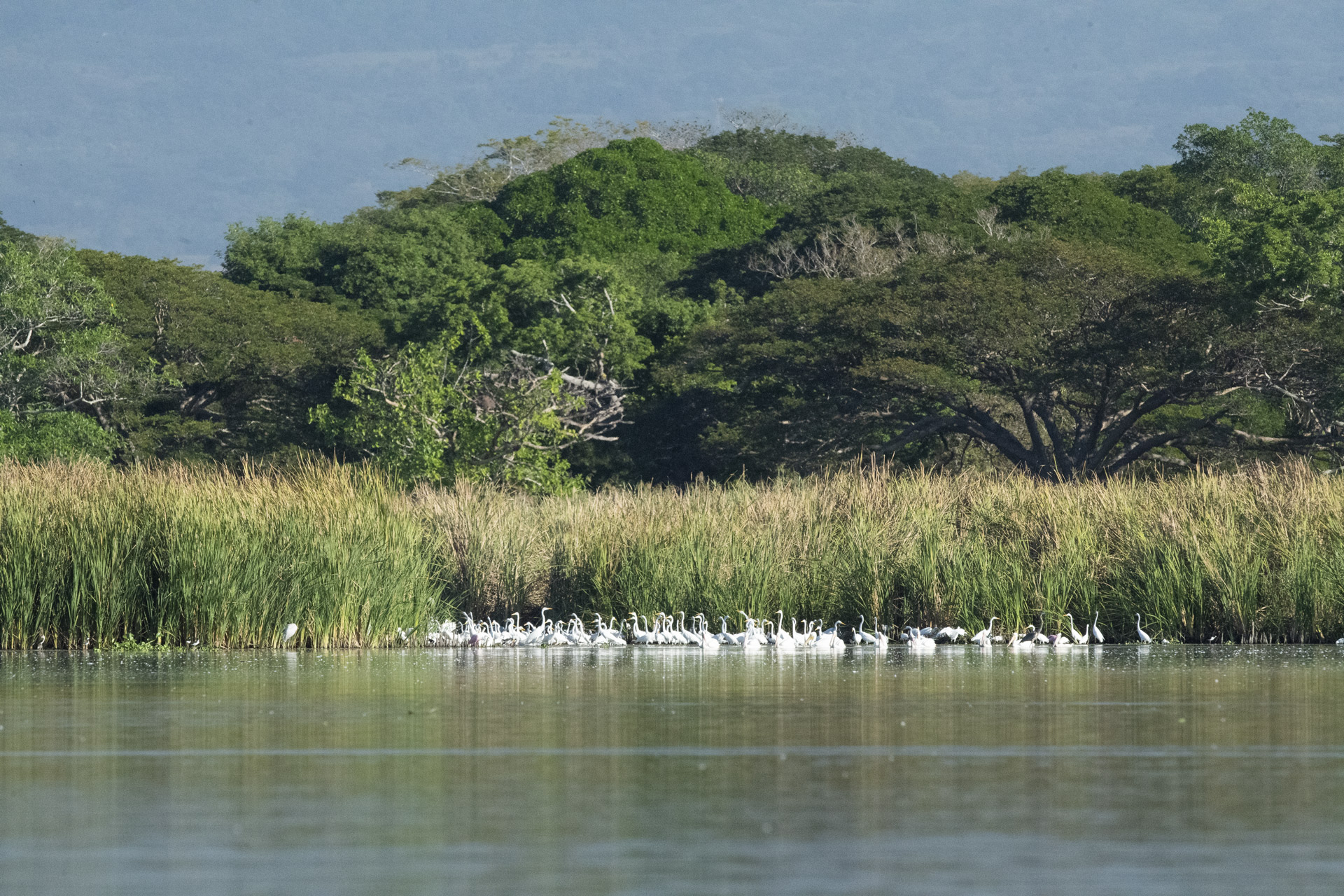
A few American white pelicans were also present; these Pelecanus erythrorhynchos are swimming birds, and they were primarily on the outside and swam away first (since pelicans are constantly moving when they fish as a group).
Photograph by Nicholas Hellmuth with Nikon D5 camera, 800mm prime Nikkor lens, January 16, 2021.
Here is the complete list:
- Ardea alba¬ - Garza blanca, great white heron, great white egret - 95% (between 40 and 60 individual birds, en masse)
- Ardea Herodias – Garza gris - 1 bird, maybe two
- Egretta thula¬ – Snowy egret - several (five to ten perhaps)
- Eudocimus albus – White ibis – at least one
- Himantopus mexicanum - Candelero or Black-necked stilt - several
- Mycteria americana – Cigueña or Wood Stork - 1 bird only
- Platalea ajaja – Roseate spoonbill - 2 birds only
- Pelecanus erythrorhynchos, white pelicans, a swimming bird, not a wader
Total: 7 wading birds + one swimming bird = 8 waterbird species in one tiny area
Waterbird reports are in the works
We would like to return to both Auto Safari Chapin nature reserve and then spend two days in the swamps, marshes, and lagoons to see what waterbirds we can find and photograph in late February or March.
If you would like make a tax deductible to cover the cost of this late February or March field trip, plus your personal costs, you and your family or friends would be welcome. We have Nikon, Canon, and Sony cameras available.
First posted January 19, 2021























